Tiger Rescue
[vc_row][vc_column][vc_column_text]
Welcome Three New Tigers;
Amanda, Arthur and Andre!
It’s a heart-warming rescue of three adult tigers from Wild Animal Orphanage (WAO), a San Antonio, Texas sanctuary that went bankrupt in 2010.
 In 2003, Wild Animal Orphanage (WAO) took in 24 tigers that had been living at a New Jersey facility that was shut down by the state. After declaring bankruptcy in 2010, WAO contacted the Global Federation of Animal Sanctuaries and other organizations for help in placing these tigers and the rest of their big cats at other sanctuaries.
In 2003, Wild Animal Orphanage (WAO) took in 24 tigers that had been living at a New Jersey facility that was shut down by the state. After declaring bankruptcy in 2010, WAO contacted the Global Federation of Animal Sanctuaries and other organizations for help in placing these tigers and the rest of their big cats at other sanctuaries.
WAO struggled for over a year to find permanent homes for all of their cats because it is hard to place a big cat who will cost $10,000 per year in food and vet care.
Amazingly, an anonymous donor couple who had known these tigers as cubs fortuitously stepped in to fund the ongoing care of three lucky tigers who are coming to Big Cat Rescue. Your donation today helps us continue our work to end the trade in big cats and makes it possible for us to rescue others and provide permanent care to more than 100+ big cats who call Big Cat Rescue home.
Please consider making a recurring donation as these help us plan better for future rescues.
See some of the press they got when they arrived:
https://www2.tbo.com/news/breaking-news/2011/sep/28/3/3-tigers-find-new-home-at-big-cat-rescue-in-citrus-ar-261210/
https://www.myfoxtampabay.com/dpp/news/local/hillsborough/tampa-is-new-home-for-three-‘big-cats’-092811
https://bigcatrescue.org/category/news-bcr/
More About These Tigers
A couple who had fallen in love with several tiger cubs back in 1996 began an amazing journey 15 years later to find out what happened to them after the facility had been shut down. In 2003 24 tigers had been sent to a sanctuary in TX which then shuttered its doors in 2010.
By comparing stripe patterns on the old cub photos to the adult cats it was determined that the 6 of the 7 of the tigers were a match or partial match to the old cub photos. As the TX facility was struggling to find homes for the last of their many tigers they were elated that this couple stepped in to help arrange permanent placement at Big Cat Rescue for three of them and at another good facility for the other four. These anonymous donors have taken on the Lion’s share of this commitment, but we need your help to raise the funds for transportation and for cage enlargements.
The photos below are NOT where the tigers are now. It is where they were in 2003. They are posted here to let you know what these tigers have endured. You can help bring them to the safety of a forever home at Big Cat Rescue now.
 |
Note that the Big Cat Rescue logo is on the screen to show that we supplied the images, but the images of abuse were not filmed at the sanctuary. They were filmed under cover, in malls or at facilities where we rescued cats.
TIGERS
IN
AMERICA

Ten Things You Probably Don’t Know about Tigers
- 1. Population:
It took 2 million years for the tiger to evolve into the biggest and most majestic cat in the world. In 1900 there were 100,000 tigers in the wild (India, SE Asia and Russia) and none in the United States. In 2010 there are only 3,000 remaining in the wild and an estimated 7,000 to 10,000 in the U.S. All the U.S. tigers are bred here and held here in captivity.
Accredited zoos have 236 pure bred tigers in the Species Survival Plan. They also have a few tigers that are cross bred between two subspecies, like Bengal bred to Siberian. These are referred to as “generic” and have no conservation value. Less than 100 tigers are estimated to be used in circuses. A few hundred are in true sanctuaries. The rest, representing the vast majority of tigers in the U.S., are owned by Exhibitors who exploit them for profit, Breeders who make money selling them, or private individuals who have them as “pets.”
Commercial use generic tigers are never reintroduced into the wild because they are not pure bred and they can’t hunt. They are typically not accepted by zoos because they are not pure bred.
For reasons discussed below, the vast majority live in small, concrete and chain link prison cells in conditions that most people would readily perceive as deplorable. Many die prematurely of disease, neglect, starvation, being put down when no longer wanted, or shot in a cage for money.
The photos on the following page and at the end of this document are not the exception, the few “bad apple” owners. They are the rule throughout our nation. This should be an embarrassment to every American.
 |
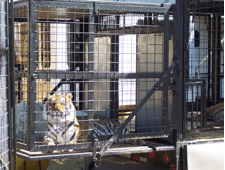 |
|
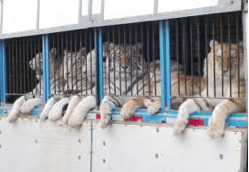 |
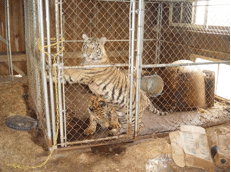 |
|
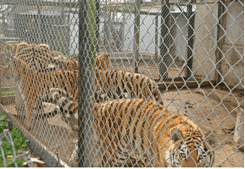 |
 |
- 2. Breeders:
Up until the 1960s breeding exotic cats was primarily in the hands of zoos and a small number of related breeders focused on preserving the species. In 1972 Siegfried and Roy began their tiger act in Las Vegas. It ran for almost 6,000 performances, ending in 2003 when one of Roy’s tigers bit him in the neck. In the span of 30 years their act popularized the notion that tigers could be trained and white tigers were a rare and special breed. Along with other tiger acts and tigers used in advertising and as celebrity ornaments, the idea of exotic pet ownership took hold with people believing you could buy and care for these cats and they would become your household pets.
As popularity and demand increased, the supply in the form of backyard breeders multiplied as they became purpose driven Breeding Farms.
They breed generic tigers that are used for pay to play sessions where the public pays to pet or pose with a baby tiger. USDA regulations only permit this petting for one month, when the cats are 8-12 weeks old. Once they are too old to use they are usually discarded into the pet trade, warehoused in tiny, barren cells, or may disappear into the black market for tiger parts.
In the wild, a mother tiger breeds about every three years. It takes that long to raise and train a litter of cubs. Breeders now take the baby tigers away from their mothers when they are only a few days old; the mothers are bred again as many as 3 times each year. This takes a huge toll on breeding females and makes an equally harmful impact on the cubs. Tigers are genetically geared to be — and to have — the fiercest and most protective and loyal mothers in the world. After ten years of breeding 20 to 30 litters, the mothers are discarded and often die of breast cancer.
In 1998 the U.S. Fish & Wildlife Service (FWS) decided it was too much bother to deal with every back yard breeder who wanted a permit to sell tigers, so they created a “generic” tiger loophole. Tigers, including generic ones, are still considered “endangered” under the Endangered Species Act. Normally people who want to buy, sell or transport an endangered species across state lines must register and report on their activities.
Exempting the generic tiger from these requirements means only AZA accredited zoos who breed pure subspecies are registered and have to report. FWS has no idea where the thousands of generic tigers are and has no way to know if they are going into the highly profitable illegal trade in their parts and “derivatives” like tiger bone wine and alleged medicinals.
It was the worst move the U.S. has ever made for tigers. Now the problem is of epidemic proportions with as many as 8,000 tigers languishing in tiny, filthy cages and daily dropping off the radar as there is no one monitoring what happens to them.
Laws that can’t be enforced:
It is impractical to have enough inspectors to properly monitor all these tigers. In the relatively few cases where the agencies do try to enforce the laws, the process typically involves years of citations and then years of court battle. Meanwhile, the tigers spend a major portion of their lives in squalid conditions while that is happening.
Even if there were better laws and unlimited enforcement resources, the problem is that if the agencies closed down all the abusers, there would no place for the tigers to go. The few true sanctuaries have limited capacity, are frequently at capacity, and in some cases may have already taken in more tigers than they may be able to support long term.
Law enforcement agents have an incentive not to shut down a breeding mill or a roadside zoo because they don’t have a place for the tigers to go. They don’t want to go into a facility and euthanize 25 tigers and explain to the community on the evening news just how this happened and why they can’t do anything to stop it.
There are currently 348 facilities in this country that hold USDA licenses to use big cats for commercial purposes (breeding, selling or exhibiting) and there is no public record of what happens to any of them.
- White Tiger Myth:
There is no such species as the Royal White Bengal Tiger. That name was invented by exhibitors to sell these cats as a rare endangered species that had to be preserved for future generations.
In the wild if two tigers, both with the specific recessive white gene, gave birth to a cub there is a 1 in 10,000 chance it will be white. It will not survive in the wild because it has no ability to camouflage itself and is genetically inferior to its brothers and sisters.
In the 1970s in a zoo in South Dakota there was a litter with a white cub. That litter was bought by a dealer and sold to a breeder who began inbreeding them (brother to sister, father to daughter, etc.) to produce more white cubs which he sold throughout the country to other breeders. This inbreeding which has been going on for 40 years continues today with their offspring because of the demand for white tiger cubs. They have sold for as much as $50,000. The $30,000 ad below is from the June 2011 of Animal Finders Guide.
Some breeders believe that if they continue the inbreeding they will be able to produce a cub that is pure white (no color and no stripes) that will be worth $100,000.


In contrast, once the normal golden cubs are too big to exploit in “pay to play” exhibits, they are sold for under $1000 or even given away.


Because the white gene is so recessive, when two white tigers are bred, most of the offspring are unwanted golden tigers.
Breeders have experienced mortality rates as high as 80% because the gene is a deleterious mutation co-linked to other mutations that cause immune deficiency, scoliosis of the spine, cleft palates, club feet, and impaired vision.
All white tigers have crossed eyes, whether it shows or not, because the gene that causes the white coat always causes the optic nerve to be wired to the wrong side of the brain. That is one reason white tigers are such a favorite in tiger acts. They are far more dependent on their masters because they can’t see clearly and their reaction time is diminished due to their genetic impairments. Only 1 in 30 of the white cats can consistently perform.
So the next time you see a tiger perform, keep in mind that for every white tiger you see there may hundreds of tigers who were discarded or died to make that one performing white tiger possible.
- 4. Exhibitors:

Some exhibitors offer to let you pet a tiger cub for a fee. This happens at the “park”, “reserve”, “preserve”, “zoo” or “sanctuary” (not a real sanctuary), or whatever they call the permanent facility where the animals are kept. Other exhibitors have a mobile exhibit that may go out to venues for a day or travel almost constantly setting up in malls and fairs. The cubs are taken from their mothers soon after birth, a torment to both cub and mother, and then carted around to strange settings to be groped by strangers hour after hour. One such exhibitor had 23 cubs die in 2010. How many other cubs died in the hands of such exhibitors is not tracked.
As noted above, federal regulations only permit cub petting for 4 weeks (from 8 to 12 weeks of age). Florida law allows contact up to 25 pounds. Exhibitors have been known extend the display time by underfeeding or giving pills to cause diarrhea, which keeps the cub as small as possible but can lead to permanent health issues. When used for “photo ops”, the repeated close camera flashes can injure their eyes.
Once the cubs are too old or too big for petting, they are sold, given away, returned to the breeder if they were leased, and almost all spend the rest of their lives, up to 20 years, in miserable conditions. One exhibitor who has both a park and a retail store in a shopping center for cub petting has admitted privately that it requires 200 cubs per year to operate his petting business. He recently stated publicly he has 67 tigers at his facility. Where did the rest go?
Other exhibitors display full grown tigers, again either at their facility or offsite. When offsite, the cats typically are confined to a small wheeled wagon where they can do little more than stand up and turn around, pace, or lie down all day long, often in a hot parking lot.
Exhibitor education is doing more harm than good:
In order to justify their tax exempt status, exhibitors say educating the public about wildlife conservation is one of their goals.
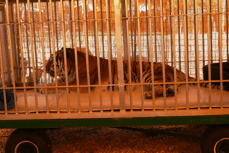
There is no evidence that people who hear these exhibitors talk about conservation take any action that supports preservation of the tiger in the wild. R.L.Tilson, in a research report on private ownership of tigers, reported that, “During the 2002 Tiger SSP Master Plan meeting, there was a consensus among the participants that handling tigers in public places…promotes private ownership and a false sense of security in handling big cats….”
Exhibiting cute cubs gives the impression that these cats do make good pets even when exhibitors say they do not. The message the exhibitors end up conveying is that you should not own a tiger unless you are “special” like they are. The same people “teaching” that tigers should not be pets often sell them or even give them away once they are too big to use for petting.
Many of these facilities are in remote locations, but some are in residential neighborhoods. These operations frequently inappropriately call themselves “sanctuaries” or “rescues” but are dangerous for humans as well as the cats and substandard by any measure, especially cage sizes.
- 5. Cages:
Federal regulations do not even have a minimum cage size. They just have language about being able to make “postural movements.” The only citation for cages being too small known to those we consulted was a woman in Florida who put more than 68 tigers in small cages in one trailer. Unlike federal regulations, Florida law at least defines a minimum cage size: two tigers can be kept for their entire lives in a 10′ by 20′ concrete and chain link box with nothing to do but pace until they are exhausted and then lie down on a concrete floor. And Florida’s law is the most generous we found. A tiger in the wild roams from 9 square miles (Bengal) up to 400 square miles (Siberian) every year. A tiny barren cell is no life for these majestic creatures.
- 6. Pet Owners:
In many states tigers can be owned as pets. Individuals, often well intentioned and frequently misled by the breeders, acquire a cub a few weeks or months old. New owners are told to have the tiger de-clawed and sometimes defanged. Some sellers will do it themselves without vet supervision. In all cases it is painful and frequently it is done improperly and causes lifelong health problems.
The cat is almost fully grown physically at 3 years old, at which point it is at least 10 times stronger than its owner. The tiger, who cannot be trained NOT to be a tiger, becomes a threat to the owner, his family and neighbors. Enclosures have to be enlarged and strengthened, the tiger may be taunted by neighborhood kids, vet treatment is difficult, repeated tranquilization can affect the cats’ kidneys, and the cost to properly feed and provide medical care can be $10,000 per year. At this point if the owner no longer wants the cat, there are few options. There are no shelters or adoption facilities as there are for domestic cats, and zoos won’t accept it because it is a hybrid. A few lucky ones end up in one of the few good sanctuaries. The rest end up in bad places or dead.
- 7. Illegal Trade in Tiger Parts and Derivatives:
The illegal trade in exotic animals is second only to the drug trade in the U.S. A live adult tiger can be purchased for a few hundred dollars. It is worth $5,000 dead. The internet sites that advertise tiger parts are called “Dead Zoos”. The tiger’s head, paws, skin, bones, eyes and other parts as well as its meat are sold into the black market. Independent dealers collect up to 10 animals at a time, deliver them to a slaughter house/ taxidermist where they are shot in the cages they arrive in and subsequently dismembered. It takes multiple shots to complete the kill because they will shoot the tiger in the chest to avoid bullet holes in the head.
- 8. Canned Hunts:
Anecdotal evidence strongly suggests that another outlet for unwanted tigers is canned hunts. This is where they are fenced into a corner of a ranch and hunters who pay up to $25,000 are guaranteed to be able to shoot a tiger. The cats are kept hungry before the shoot and because they were raised by humans they will approach you for food which makes it easier to kill them. In one video of a lion canned hunt, the lioness is drawn into close range by luring her with her own cubs, then shot leaving the cubs motherless. More advanced variations of canned hunts where remote controlled guns that can be focused and fired from your computer in the convenience of your home or office have taken place.
- 9. Sanctuaries:
In the 1990s a few people familiar with the abuse began to form sanctuaries for these cats: places that would provide a suitable place for them to live out their lives, free from abuse and without the obligation to perform or breed and to have enough food and proper medical care.
True sanctuaries accept cats from private owners that can no longer care for them, from circuses when they are too old to perform, as well as tigers rescued in emergency situations when state or county wildlife agencies are left with the cats when a breeder or exhibitor is shut down and the cats are left without a home.
True sanctuaries can only take a limited number of the big cats who need to be rescued. The rest live at substandard facilities or die.
Unfortunately there are no qualifications needed to name or advertise oneself as a sanctuary so most who claim to be sanctuaries are Breeders and Exhibitors that have renamed themselves as sanctuaries to encourage fundraising by selling the story, when in fact their purpose is to generate additional revenue with no obligation to improve the conditions or lives of the cats. Having IRS status as a 501(c)(3) nonprofit does not mean a facility is a sanctuary.
Before getting involved with a sanctuary you should research it and if possible go visit in person. If you find a place that breeds, buys, sells, exhibits off site, features cubs (especially white ones), lets you handle them, has animals perform, has cramped enclosures and/or is short staffed, you are in a roadside zoo at best and a breeding facility at worst. Please do not support those facilities.
An accredited sanctuary takes on an enormous financial burden when it accepts a tiger because it commits to provide for a cat for the rest of its life. They are all privately operated nonprofit organizations and exist without government subsidy.
Their ability to take in tigers is a function of their private fundraising. They need your help.
- 10. WHAT YOU CAN DO TO HELP:
A. Become a Big Cat Rescue “Advocat”.
Big Cat Rescue, an accredited sanctuary in Tampa, FL, is a leader in advocacy for tigers and other big cats. They have a very sophisticated online system that monitors laws related to big cats and makes it very easy for you to add your voice. It identifies your representatives for you and provides a template that you can edit and quickly send an email urging better laws or regulations.
Big Cat Rescue also identifies malls, fairs and other venues that permit abusive displays like the cub petting. When a venue is identified, often Big Cat Rescue sends an alert to their Advocats asking them to email that venue objecting to the exhibit. Even if you are not in that geographic market, the volume of emails shows the venue that many members of the general public, i.e. their customers, oppose this abuse. While the exhibit may draw visitors who are not aware of the suffering that these exhibits inflict, the emails show that the venue is offending other customers, which is bad business. Dozens of venues have agreed to cancel these exhibits or not have them in the future after receiving thousands of emails from people like you who care.
Big Cat Rescue also emails a monthly newsletter with updates about events at the sanctuary and advocacy issues. They do not rent, sell or trade your email address to anyone else. This is a great way to help that takes little time and no cost. Over 50,000 people who care about big cats are now Advocats. To sign up, visit bigcatrescue.org/advocat.
B. Periodically Visit CatLaws.com
CatLaws.com is the website where Big Cat Rescue’s system tracks relevant laws and current venue abuse and other issues where your voice can make a difference. Visit the site periodically to see if there are any issues you have not already acted on.
C. When You See an Exhibit or Unaccredited Zoo
Be sensitive to your own patronage of places that add to the problem. When you see a cub or adult tiger exhibit, voice your objections to the management of the venue. Nothing is as powerful as real customers saying I won’t shop here anymore. If you do see a traveling exhibit, particularly one with cubs, report it to info@BigCatRescue.org. When you want to visit an animal facility, make sure it is an accredited zoo or real sanctuary, not a road side zoo or pseudo sanctuary where your patronage just adds to the problem.
D. Call and fax your legislator
When there is a current bill, call your legislator and fax a personal letter. This takes more of your time than the email you sent from CatLaws.com, but if you can make the time, it is far more effective! The reason is that so few people do it. For every person who takes the time to call or fax, the legislator’s staff assumes many, many more feel that way simply because it does take effort that most people won’t make. One day when the Founder of Big Cat Rescue was in the reception area of one of her legislators before an appointment, one of staff ended a call and turned to the other staff person and said “that is the 12th call I’ve gotten today on that issue – people must really be worked up about it!” It takes very few phone calls or non-form letter faxes to make a big impression. If a bill is not ready for immediate vote, you want to ask your legislator to “co-sponsor” the bill. That means they sign on in advance committing to vote for it. If the vote is imminent and your legislator is not a co-sponsor, you want to ask them to vote for the bill.
Canned Hunting Bill. At this writing, the current bill that needs your support is H.R. 2210, The Sportsmanship in Hunting Act of 2011. It would end the horrible practice of “canned” hunting, including Internet hunting, where animals raised in captivity are shot like targets in a carnival booth. To help, read more at https://bigcatrescue.org/2011/hr-2210/ and ask your Representative to co-sponsor this bill.
E. Vote for Legislators who Support Animal Protection Legislation
At election time, support candidates who care about animals. You can see incumbents’ voting records on animal issues in the “scorecard” maintained by the Humane Society Legislative Fund www.hslf.org/humanescorecard/. Preventing cruelty to animals should not be a partisan issue. It should be an American issue.
F. Financially Support a Sanctuary
As discussed above, sanctuaries struggle for financial resources to support the tigers and other exotic cats they take in. You can donate to Big Cat Rescue at BigCatRescue.org. In addition to excellent care for rescued animals, they stand out as a leader in the advocacy work that can stop the abuse and therefore stop the flow of animals needing to be rescued. There are a limited number of other true sanctuaries that you can support. Just be wary of places that call themselves sanctuaries but are really “pseudo” sanctuaries that breed, buy, sell, or exhibit offsite. One resource to research them is the Global Federation of Sanctuaries, the most recognized accrediting body. See www.sanctuaryfederation.org.
G. Tell Your Friends
There is power in numbers! Please share this information with people you know. Ask them at least to join as Advocats and to avoid patronizing abusive venues, which takes little effort. Urge them to take the more proactive steps above and donate if they can.
Final Thought:
We should not let our society be defined by a group of inhumane, greedy breeders and exhibitors. We are a better people, we owe it to ourselves to take care of animals that did not choose to be born into captivity in the United States and then be brutalized by their owners.
If you are a tiger born in this country
|
This how life begins |
This is where you live |
|
 |
 |
|
|
This is what you look forward to |
This is how it may end |
|
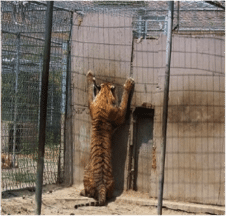 |
 |
Together we can change this!
KILL THE PROFIT POTENTIAL – NOT THE TIGER
Amanda, Arthur and Andre at Big Cat Rescue
[/vc_column_text][/vc_column][/vc_row]







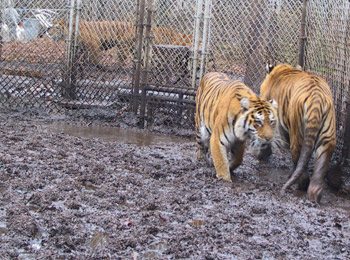



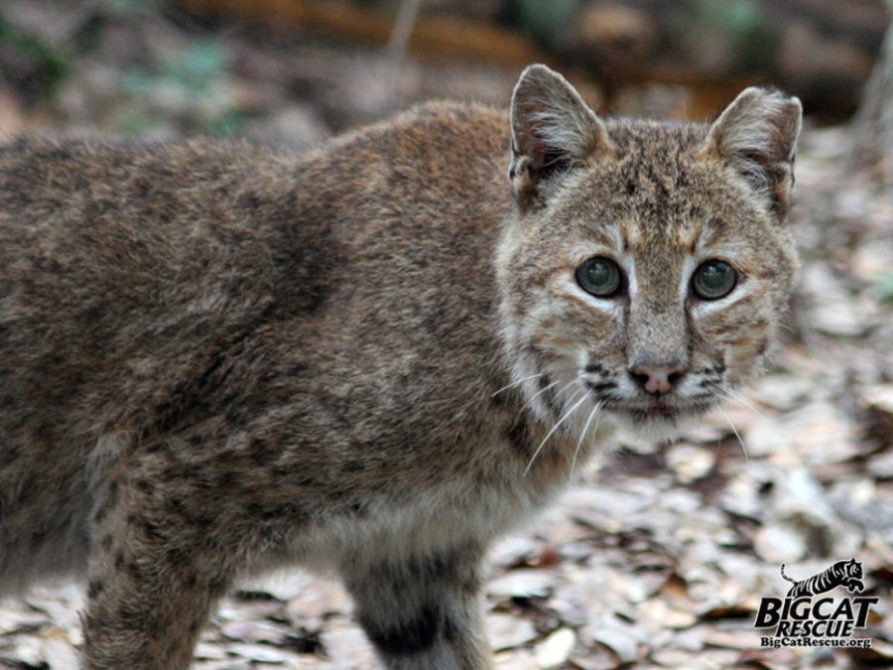

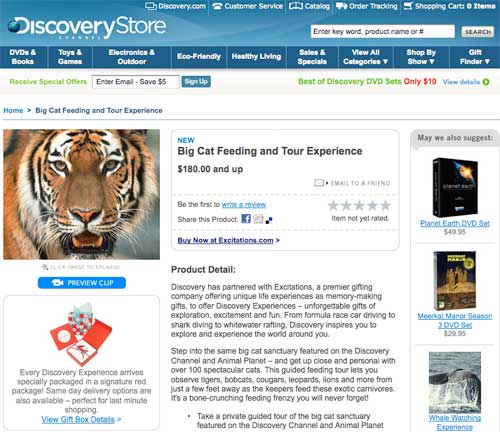
How tigers are exploited in the U.S. is tantamount to torture…Please do not support the deplorable people who abuse tigers by using them.
Thank you for the list of ways to help, I have been looking for direction and this is getting me started on the right path.
I'm ashamed that the term 'canned hunt' exists, and the definition is what it is… it is just ridiculous that any person could/would want to participate in something of this sort…
Do you have a specific date you are rescuing them?